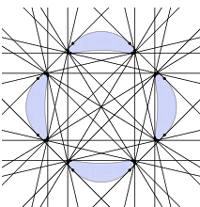Schubert showed that a plane algebraic curve of degree $d$ has at most $$ \tfrac{1}{2} d (d-2) (d-3) (d+2) = \tfrac{1}{2}d^4-d^3-\tfrac{9}{2} d^2 +9 d $$ bitangents (a.k.a., double tangents). And this number of real bitangents is achievable for a quartic, such as Trott's quartic:

(Image from Mathworld.)
(I learned this from Jan-MagnusØkland @MSE.)
I have a curve $C$ that is a subcurve of a real algebraic plane curve of degree $d$, with these restrictions:
- $C$ is connected (unlike Trott's quartic).
- $C$ is simple, i.e., non-self-intersecting, i.e., it is embedded.
- $C$ has no cusp singularities.
- $C$ is an open curve, i.e., it is not closed to a cycle.
My question is:
Q. Under these restrictions, is there a smaller upperbound than provided by Schubert's formula? In particular, are there curves $C$ meeting my conditions still with $\Omega( d^4 )$ bitangents? Maybe instead $O(d^3)$ holds?
